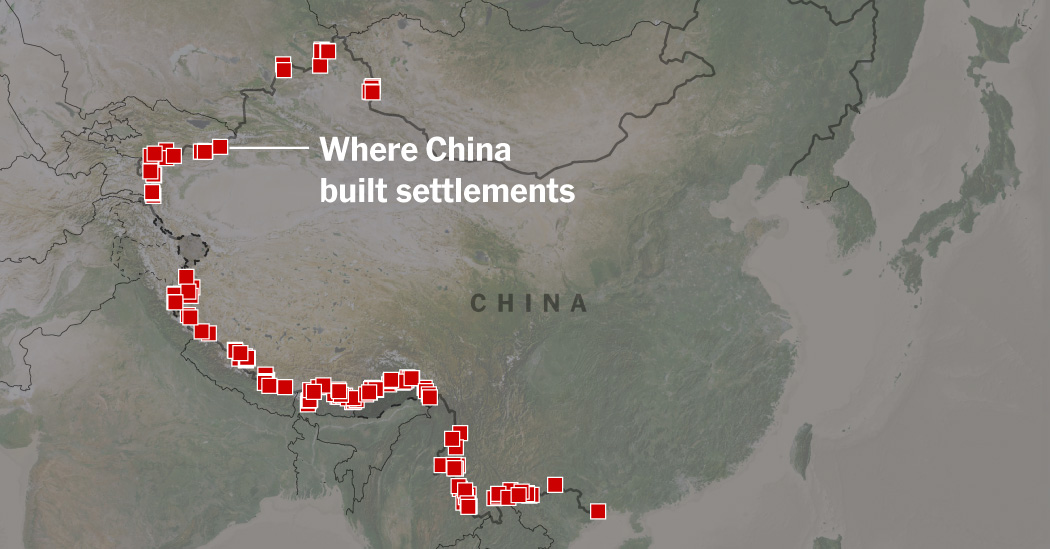- cross-posted to:
- china@sopuli.xyz
- world@lemmy.world
- cross-posted to:
- china@sopuli.xyz
- world@lemmy.world
cross-posted from: https://feddit.org/post/1843331
In addition to the 50 new villages, China added new homes to 100 other villages, to house even more people.
These civilian outposts are one way that Beijing is projecting its power abroad and securing its rule at home.
Qionglin New Village sits deep in the Himalayas, just three miles from a region where a heavy military buildup and confrontations between Chinese and Indian troops have brought fears of a border war.
The land was once an empty valley, more than 10,000 feet above the sea, traversed only by local hunters. Then Chinese officials built Qionglin, a village of cookie-cutter homes and finely paved roads, and paid people to move there from other settlements.
**China’s leader, Xi Jinping, calls such people “border guardians.” ** Qionglin’s villagers are essentially sentries on the front line of China’s claim to Arunachal Pradesh, India’s easternmost state, which Beijing insists is part of Chinese-ruled Tibet.
Many villages like Qionglin have sprung up. In China’s west, they give its sovereignty a new, undeniable permanence along boundaries contested by India, Bhutan and Nepal. In its north, the settlements bolster security and promote trade with Central Asia. In the south, they guard against the flow of drugs and crime from Southeast Asia.
The buildup is the clearest sign that Mr. Xi is using civilian settlements to quietly solidify China’s control in far-flung frontiers, just as he has with fishing militias and islands in the disputed South China Sea.
[…]
The mapping reveals that China has put at least one village near every accessible Himalayan pass that borders India, as well as on most of the passes bordering Bhutan and Nepal, according to Matthew Akester, an independent researcher on Tibet, and Robert Barnett, a professor from SOAS University of London. Mr. Akester and Mr. Barnett, who have studied Tibet’s border villages for years, reviewed The Times’s findings.
The outposts are civilian in nature, but they also provide China’s military with roads, access to the internet and power, should it want to move troops quickly to the border. Villagers serve as eyes and ears in remote areas, discouraging intruders or runaways.
[…]
The buildup of settlements fuels anxiety in the region about Beijing’s ambitions. The threat of conflict is ever present: Deadly clashes have broken out along the border between troops from India and China since 2020, and tens of thousands of soldiers from both sides remain on a war footing.
[…]
Of the new villages The Times identified in Tibet, one is on land claimed by India, though within China’s de facto border; 11 other settlements are in areas contested by Bhutan. Some of those 11 villages are near the Doklam region, the site of a standoff between troops from India and China in 2017 over Chinese attempts to extend a road.
China makes clear that the villages are there for security. In 2020, a leader of a Tibetan border county told state media that he was relocating more than 3,000 people to frontier areas that were “weakly controlled, disputed or empty.”
[…]
Indian officials have previously noted “infrastructure construction activity” by China along the border. Local leaders in Arunachal Pradesh and Ladakh have complained to The Times that China was slowly cutting away small pieces of Indian territory.
[…]
Among other findings, the C.S.I.S. [Center for Strategic and International Studies in a] report identified what appeared to be a militarized facility in one such village, known as Migyitun, or Zhari in Chinese, an indication of the settlements’ dual-use nature.
[…]
To persuade residents to move there, Chinese Communist Party officials promised them their new homes would be cheap. They would receive annual subsidies and get paid extra if they took part in border patrols. Chinese propaganda outlets said the government would provide jobs and help promote local businesses and tourism. The villages would come with paved roads, internet connections, schools and clinics.
[…]
Some villagers may be receiving around 20,000 Chinese yuan a year for relocation {according to a government document], less than $3,000. One resident reached by phone said he earned an extra $250 a month by patrolling the border.
[…]
The residents become dependent on the subsidies because there are few other ways to make a living.
[…]
China’s relocation policy is also a form of social engineering, designed to assimilate minority groups like the Tibetans into the mainstream. Tibetans, who are largely Buddhist, have historically resisted the Communist Party’s intrusive controls on their religion and way of life.
[…]
When money isn’t enough, Chinese officials have applied pressure on residents to relocate, an approach that was evident even in state propaganda reports.
A documentary aired by the state broadcaster, CCTV, showed how a Chinese official went to Dokha, a village in Tibet, to persuade residents to move to a new village called Duolonggang, 10 miles from Arunachal Pradesh.
He encountered some resistance. Tenzin, a lay Buddhist practitioner, insisted that Dokha’s land was fertile, producing oranges and other fruit. “We can feed ourselves without government subsidies,” he said.
The official criticized Tenzin for “using his age and religious status to obstruct relocation,” according to a state media article cited by Human Rights Watch in a report.
In the end, all 143 residents of Dokha moved to the new settlement.



@0x815 as a fun fact (probably losely related to this but anyway), this is the modern version of what the (former) Kingdom of Hungary did in medieval times with the Szekely and the German speaking minorities in Transylvania (in today’s counties of Covasna and Harghita) - only that they also recruited these people into the army.
Fast forward to today, this is why we have a substantial minority of Hungarians in the geographical middle of the country.
I mean even more recently its exactly what Israel is doing with their “settlements” in gaza and the westbank.